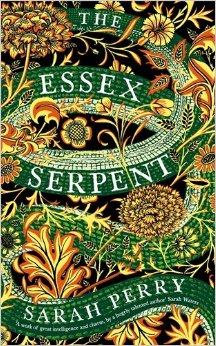
Again, life always seems to get in the way of posting these on time at the end of the month. Ascribing to the maxim ‘better late than never’, though, here are my musings and book recommendations based on what I read last month. Overall I didn’t feel like March was a particularly strong month – some of the books I read left me cold, despite all the hype around them, which was perhaps the problem – and I also didn’t manage to read that much as it was quite a hectic period due to the London Book Fair.

I’m ashamed to admit that I didn’t read Sarah Perry’s critically acclaimed and bestselling novel, The Essex Serpent until now, a risky strategy, given all the praise it’s received. My expectations were therefore sky-high, and that coupled with the fact that I love historical fiction and read a lot of it meant I was desperate not to be let down. Having read it I can now understand why it has been almost universally adored. Cora Seaborne – the novel’s protagonist – is a frustrating, flawed and fascinating women, drawn to the Colchester mud because of rumours the mythical serpent has reappeared. Her investigations lead her into contact with a local vicar and the intellectual rapport between them is what drives and sustains the novel, giving rise to questions of religion, science, discovery and the difference between truth and belief. A delight to read sentence by sentence, but also a novel that will encourage the reader to ask as many questions as the characters.
 The Truth About the Harry Quebert Affair was originally published in France about five years ago, and first appeared in English translation in 2014, so it’s a few years old now. It caused something of a sensation when it was acquired as the author was a young debut novelist and the book is almost 700 pages long, which makes for an expensive translation. It certainly makes for compulsive, page-turning reading. Thirty-three years ago, a fifteen-year-old girl went missing in Somerset, New Hampshire. Now, her body turns up buried in the grounds of a property rented by a famous writer. The murdered girl has been buried with a copy of the writer’s latest manuscript, which brought him international fame, and money. The famous writer is Harry Quebert and it falls to one of his old students to try and clear his mentor’s name. On occasion I felt like Dicker was trying to be a touch too clever (the book sometimes felt like an exercise in metafiction), and I’m not sure it’s the literary magnum opus some made it out to be – it reads more like standard thriller in places – but this doesn’t detract from the fact that I raced through it in just a couple of days and was gripped by all the twists, turns and revelations until the very end.
The Truth About the Harry Quebert Affair was originally published in France about five years ago, and first appeared in English translation in 2014, so it’s a few years old now. It caused something of a sensation when it was acquired as the author was a young debut novelist and the book is almost 700 pages long, which makes for an expensive translation. It certainly makes for compulsive, page-turning reading. Thirty-three years ago, a fifteen-year-old girl went missing in Somerset, New Hampshire. Now, her body turns up buried in the grounds of a property rented by a famous writer. The murdered girl has been buried with a copy of the writer’s latest manuscript, which brought him international fame, and money. The famous writer is Harry Quebert and it falls to one of his old students to try and clear his mentor’s name. On occasion I felt like Dicker was trying to be a touch too clever (the book sometimes felt like an exercise in metafiction), and I’m not sure it’s the literary magnum opus some made it out to be – it reads more like standard thriller in places – but this doesn’t detract from the fact that I raced through it in just a couple of days and was gripped by all the twists, turns and revelations until the very end.

I’d been meaning to read The Farm at the Edge of the World for a while, given it’s set on the North Cornwall coast just a few miles from the area my family and I know so well, and where I go a couple of times a year just to get away from it all. Appropriately, I read it while I was in Cornwall and couldn’t have asked for a better holiday read. It’s an absorbing family drama, filled with hidden secrets, guilt, heartbreak and passion. Dual timeline novels are tricky to master and sometimes the use of that structure can feel more like a conceit than a necessity, but the two settings here – of present-day Cornwall and the Cornwall of the Second World War that became temporary home to many evacuee children – are both brilliantly portrayed. If you’re going away for Easter, or have a summer holiday planned, put this one in your suitcase; you won’t be disappointed.
Categories: Literature
Leave a comment